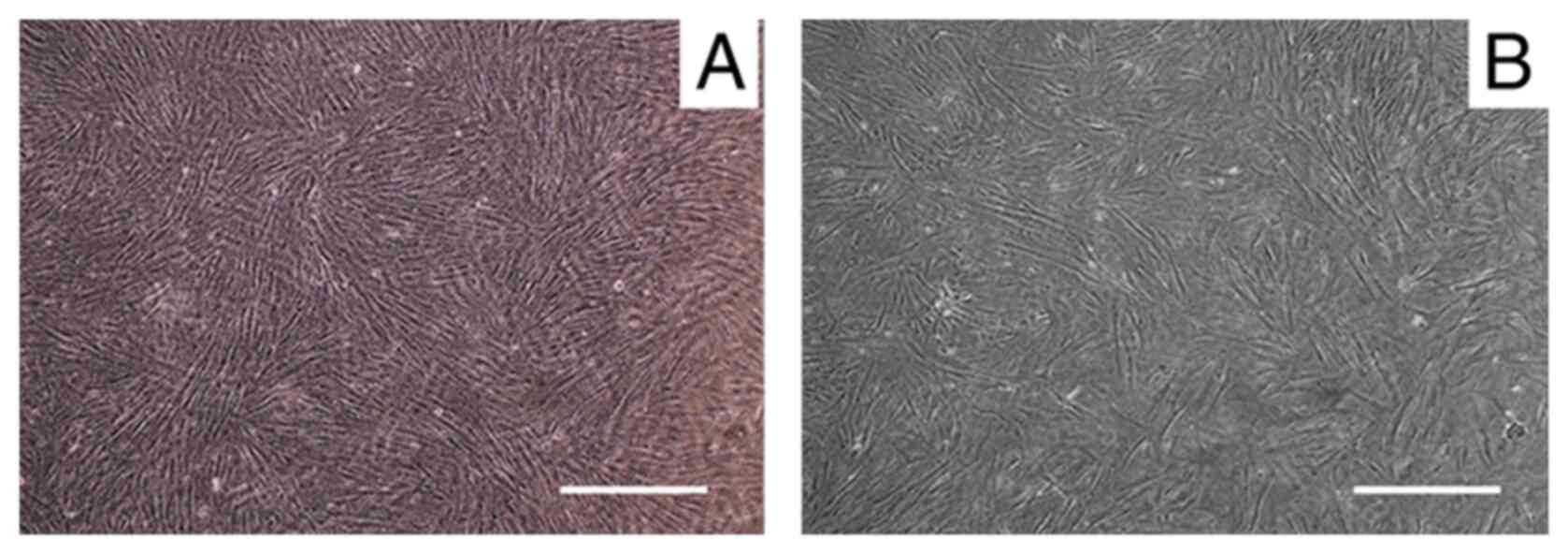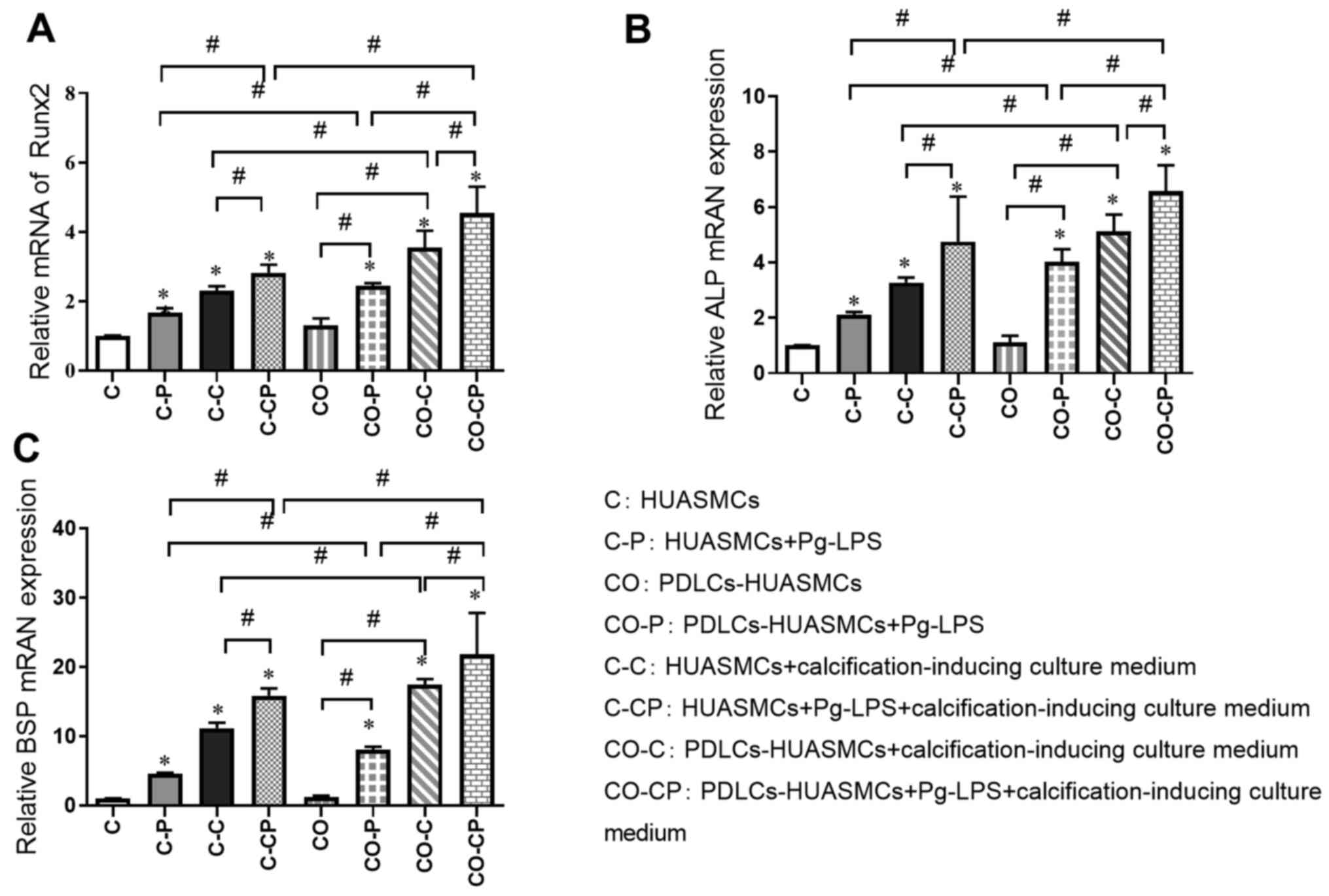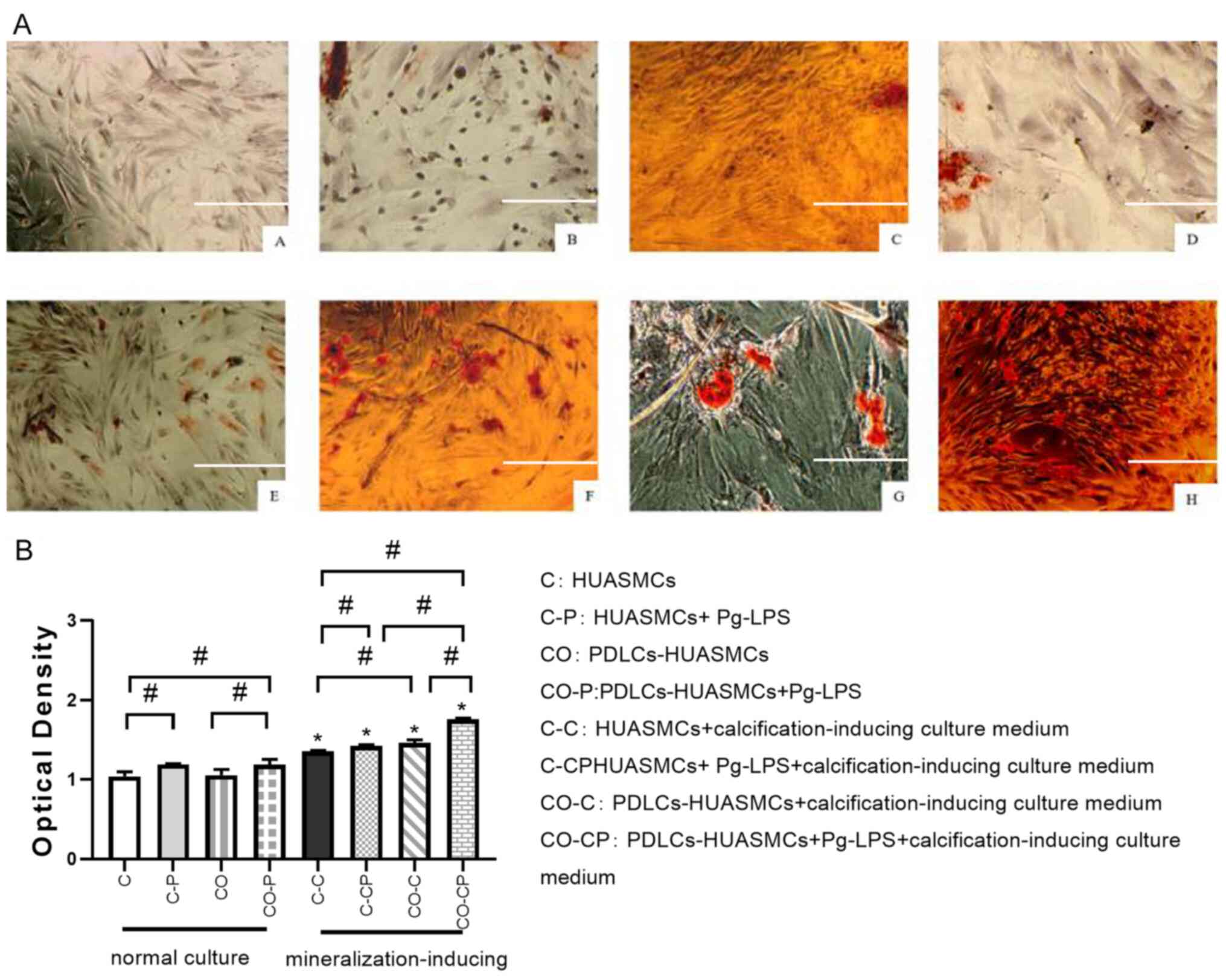|
1
|
Safi IN, Mohammed Ali Hussein B and
Al-Shammari AM: In vitro periodontal ligament cell expansion by
co-culture method and formation of multi-layered periodontal
ligament-derived cell sheets. Regen Ther. 11:225–239.
2019.PubMed/NCBI View Article : Google Scholar
|
|
2
|
Gorasia DG, Glew MD, Veith PD and Reynolds
EC: Quantitative proteomic analysis of the type IX secretion system
mutants in Porphyromonas gingivalis. Mol Oral Microbiol.
35:78–84. 2020.PubMed/NCBI View Article : Google Scholar
|
|
3
|
Maldonado RF, Sá-Correia I and Valvano MA:
Lipopolysaccharide modification in Gram-negative bacteria during
chronic infection. FEMS Microbiol Rev. 40:480–493. 2016.PubMed/NCBI View Article : Google Scholar
|
|
4
|
Le Sage F, Meilhac O and Gonthier MP:
Porphyromonas gingivalis lipopolysaccharide induces
pro-inflammatory adipokine secretion and oxidative stress by
regulating Toll-like receptor-mediated signaling pathways and redox
enzymes in adipocytes. Mol Cell Endocrinol. 446:102–110.
2017.PubMed/NCBI View Article : Google Scholar
|
|
5
|
Zhao M, Dai W, Wang H, Xue C, Feng J, He
Y, Wang P, Li S, Bai D and Shu R: Periodontal ligament fibroblasts
regulate osteoblasts by exosome secretion induced by inflammatory
stimuli. Arch Oral Biol. 105:27–34. 2019.PubMed/NCBI View Article : Google Scholar
|
|
6
|
Naruishi K: Carotenoids and periodontal
infection. Nutrients. 12(269)2020.PubMed/NCBI View Article : Google Scholar
|
|
7
|
Groeger S, Jarzina F, Windhorst A and
Meyle J: Influence of retinoic acid on human gingival epithelial
barriers. J Periodontal Res. 51:748–757. 2016.PubMed/NCBI View Article : Google Scholar
|
|
8
|
Ehara S and Yoshiyama M: Quantitative
analyses of coronary artery calcification by using clinical
cardiovascular imaging. Clin Calcium. 20:1686–1692. 2010.PubMed/NCBI
|
|
9
|
Kendrick J and Chonchol M: The role of
phosphorus in the development and progression of vascular
calcification. Am J Kidney Dis. 58:826–834. 2011.PubMed/NCBI View Article : Google Scholar
|
|
10
|
Lanzer P, Boehm M, Sorribas V, Thiriet M,
Janzen J, Zeller T, St Hilaire C and Shanahan C: Medial vascular
calcification revisited: Review and perspectives. Eur Heart J.
35:1515–1525. 2014.PubMed/NCBI View Article : Google Scholar
|
|
11
|
Bessueille L and Magne D: Inflammation: A
culprit for vascular calcification in atherosclerosis and diabetes.
Cell Mol Life Sci. 72:2475–2489. 2015.PubMed/NCBI View Article : Google Scholar
|
|
12
|
Ruiz JL, Hutcheson JD and Aikawa E:
Cardiovascular calcification: current controversies and novel
concepts. Cardiovasc Pathol. 24:207–212. 2015.PubMed/NCBI View Article : Google Scholar
|
|
13
|
Liu G, Deng J, Zhang Q, Song W, Chen S,
Lou X, Zhang P and Pan K: Porphyromonas gingivalis
Lipopolysaccharide stimulation of vascular smooth muscle cells
activates proliferation and calcification. J Periodontol.
87:828–836. 2016.PubMed/NCBI View Article : Google Scholar
|
|
14
|
Li S, Fan SX and McKenna TM: Vascular
smooth muscle cells on Matrigel as a model for LPS-induced
hypocontractility and NO formation. Am J Physiol. 272:H576–H584.
1997.PubMed/NCBI View Article : Google Scholar
|
|
15
|
Tang XL and Meng HX: The inhibitory effect
of calcitriol on the proliferation of hPDLCs populations of
different vitamin D receptor Fok I genotypes. Shanghai Kou Qiang Yi
Xue. 18:422–426. 2009.PubMed/NCBI(In Chinese).
|
|
16
|
Dong X, Wang YS, Dou GR, Hou HY, Shi YY,
Zhang R, Ma K, Wu L, Yao LB, Cai Y, et al: Influence of Dll4 via
HIF-1α-VEGF signaling on the angiogenesis of choroidal
neovascularization under hypoxic conditions. PLoS One.
6(e18481)2011.PubMed/NCBI View Article : Google Scholar
|
|
17
|
Wang YL, Pan KQ, Sun Y and Deng J: Effect
of lipopolysaccharide on the expression of ALP, BSP, DSPP in rat
dental pulp cells. Shanghai Kou Qiang Yi Xue. 23:431–435.
2014.PubMed/NCBI(In Chinese).
|
|
18
|
Young N, Mikhalkevich N, Yan Y, Chen D and
Zheng WP: Differential regulation of osteoblast activity by Th cell
subsets mediated by parathyroid hormone and IFN-gamma J. Immunol.
175:8287–8295. 2005.PubMed/NCBI View Article : Google Scholar
|
|
19
|
Aonuma H, Ogura N, Takahashi K, Fujimoto
Y, Iwai S, Hashimoto H, Ito K, Kamino Y and Kondoh T:
Characteristics and osteogenic differentiation of stem/progenitor
cells in the human dental follicle analyzed by gene expression
profiling. Cell Tissue Res. 350:317–331. 2012.PubMed/NCBI View Article : Google Scholar
|
|
20
|
Gregory CA, Gunn WG, Peister A and Prockop
DJ: An Alizarin red-based assay of mineralization by adherent cells
in culture: Comparison with cetylpyridinium chloride extraction.
Anal Biochem. 329:77–84. 2004.PubMed/NCBI View Article : Google Scholar
|
|
21
|
Liberman M, Pesaro AE, Carmo LS and
Serrano CV Jr: Vascular calcification: Pathophysiology and clinical
implications. Einstein (Sao Paulo). 11:376–382. 2013.PubMed/NCBI View Article : Google Scholar
|
|
22
|
Burton DG, Matsubara H and Ikeda K:
Pathophysiology of vascular calcification: Pivotal role of cellular
senescence in vascular smooth muscle cells. Exp Gerontol.
45:819–824. 2010.PubMed/NCBI View Article : Google Scholar
|
|
23
|
Davis-Dusenbery BN, Wu C and Hata A:
Micromanaging vascular smooth muscle cell differentiation and
phenotypic modulation. Arterioscler Thromb Vasc Biol. 31:2370–2377.
2011.PubMed/NCBI View Article : Google Scholar
|
|
24
|
Bahekar AA, Singh S, Saha S, Molnar J and
Arora R: The prevalence and incidence of coronary heart disease is
significantly increased in periodontitis: A meta-analysis. Am Heart
J. 154:830–837. 2007.PubMed/NCBI View Article : Google Scholar
|
|
25
|
Humphrey LL, Fu R, Buckley DI, Freeman M
and Helfand M: Periodontal disease and coronary heart disease
incidence: A systematic review and meta-analysis. J Gen Intern Med.
23:2079–2086. 2008.PubMed/NCBI View Article : Google Scholar
|
|
26
|
Khader YS, Albashaireh ZS and Alomari MA:
Periodontal diseases and the risk of coronary heart and
cerebrovascular diseases: A meta-analysis. J Periodontol.
75:1046–1053. 2004.PubMed/NCBI View Article : Google Scholar
|
|
27
|
Zhang YM, Zhong LJ, He BX, Nie J, Wang X
and Li WC: Study on the correlation between coronary heart disease
and chronic periodontitis. Zhonghua Liu Xing Bing Xue Za Zhi.
27:256–259. 2006.PubMed/NCBI(In Chinese).
|
|
28
|
Yang WW, Guo B, Jia WY and Jia Y:
Porphyromonas gingivalis-derived outer membrane vesicles
promote calcification of vascular smooth muscle cells through
ERK1/2-RUNX2. FEBS Open Bio. 6:1310–1319. 2016.PubMed/NCBI View Article : Google Scholar
|
|
29
|
Han F, Hou N, Liu Y, Huang N, Pan R, Zhang
X, Mao E and Sun X: Liraglutide improves vascular dysfunction by
regulating a cAMP-independent PKA-AMPK pathway in perivascular
adipose tissue in obese mice. Biomed Pharmacother.
120(109537)2019.PubMed/NCBI View Article : Google Scholar
|
|
30
|
Gharaibeh B, Lu A, Tebbets J, Zheng B,
Feduska J, Crisan M, Péault B, Cummins J and Huard J: Isolation of
a slowly adhering cell fraction containing stem cells from murine
skeletal muscle by the preplate technique. Nat Protoc. 3:1501–1509.
2008.PubMed/NCBI View Article : Google Scholar
|
|
31
|
Saldarriaga Fernández IC, Busscher HJ,
Metzger SW, Grainger DW and van der Mei HC: Competitive time- and
density-dependent adhesion of staphylococci and osteoblasts on
crosslinked poly(ethylene glycol)-based polymer coatings in
co-culture flow chambers. Biomaterials. 32:979–984. 2011.PubMed/NCBI View Article : Google Scholar
|
|
32
|
Sun Y, Shu R, Li CL and Zhang MZ:
Gram-negative periodontal bacteria induce the activation of
Toll-like receptors 2 and 4, and cytokine production in human
periodontal ligament cells. J Periodontol. 81:1488–1496.
2010.PubMed/NCBI View Article : Google Scholar
|
|
33
|
Tintut Y, Patel J, Parhami F and Demer LL:
Tumor necrosis factor-alpha promotes in vitro calcification of
vascular cells via the cAMP pathway. Circulation. 102:2636–2642.
2000.PubMed/NCBI View Article : Google Scholar
|
|
34
|
Yamamoto T, Kita M, Oseko F, Nakamura T,
Imanishi J and Kanamura N: Cytokine production in human periodontal
ligament cells stimulated with Porphyromonas gingivalis. J
Periodontal Res. 41:554–559. 2006.PubMed/NCBI View Article : Google Scholar
|
|
35
|
Thammasitboon K, Goldring SR and Boch JA:
Role of macrophages in LPS-induced osteoblast and PDL cell
apoptosis. Bone. 38:845–852. 2006.PubMed/NCBI View Article : Google Scholar
|
|
36
|
Sadowitz B, Seymour K, Gahtan V and Maier
KG: The role of hyaluronic acid in atherosclerosis and intimal
hyperplasia. J Surg Res. 173:e63–e72. 2012.PubMed/NCBI View Article : Google Scholar
|
|
37
|
Boström KI, Rajamannan NM and Towler DA:
The regulation of valvular and vascular sclerosis by osteogenic
morphogens. Circ Res. 109:564–577. 2011.PubMed/NCBI View Article : Google Scholar
|
|
38
|
Khan SZ, Kokubu E, Matsuzaka K and Inoue
T: Behaviour of rat-cultured dental pulp cells in three-dimensional
collagen type-1 gel in vitro and in vivo. Aust Endod J. 39:137–145.
2013.PubMed/NCBI View Article : Google Scholar
|
|
39
|
Ciceri P, Elli F, Cappelletti L, Tosi D,
Savi F, Bulfamante G and Cozzolino M: Osteonectin (SPARC)
expression in vascular calcification: In vitro and ex vivo studies.
Calcif Tissue Int. 99:472–480. 2016.PubMed/NCBI View Article : Google Scholar
|
|
40
|
Pang J, Zhang Y, Ke J, Yu Q, He W and Wu
B: Upregulation of dentin matrix protein 1 promoter activities by
core binding factor alpha1 in human dental pulp stem cells. Biochem
Biophys Res Commun. 357:505–510. 2007.PubMed/NCBI View Article : Google Scholar
|
|
41
|
Yin Q, Jiang D, Li L, Yang Y, Wu P, Luo Y,
Yang R and Li D: LPS promotes vascular smooth muscle cells
proliferation through the TLR4/Rac1/Akt signalling pathway. Cell
Physiol Biochem. 44:2189–2200. 2017.PubMed/NCBI View Article : Google Scholar
|
|
42
|
Lv X-C, Bi L-J, Jiang Y and Wang X:
Effects of icariin on the alkline phosphatase activity of human
periodontal ligament cells inhibited by lipopolysaccharide. Mol Med
Rep. 8:1411–1415. 2013.PubMed/NCBI View Article : Google Scholar
|




















